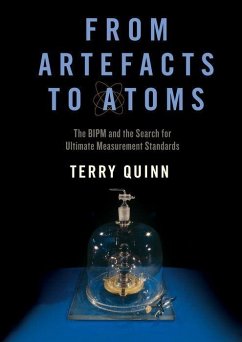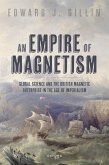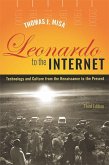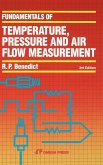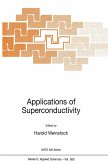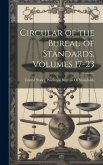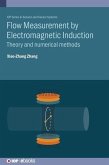Schade – dieser Artikel ist leider ausverkauft. Sobald wir wissen, ob und wann der Artikel wieder verfügbar ist, informieren wir Sie an dieser Stelle.
- Gebundenes Buch
- Merkliste
- Auf die Merkliste
- Bewerten Bewerten
- Teilen
- Produkt teilen
- Produkterinnerung
- Produkterinnerung
This is the story of the International Bureau of Weights and Measures--from its origins in the 1860s until today. It highlightes the role of key individuals in the development of the institution and the path from artifact standards of the metre and the kilogram to units based on the fundamental constants of physics.
Andere Kunden interessierten sich auch für
![An Empire of Magnetism An Empire of Magnetism]() Edward J GillinAn Empire of Magnetism111,99 €
Edward J GillinAn Empire of Magnetism111,99 €![Leonardo to the Internet Leonardo to the Internet]() Thomas J MisaLeonardo to the Internet72,99 €
Thomas J MisaLeonardo to the Internet72,99 €![Fundamentals of Temperature, Pressure and Flow Measurements Fundamentals of Temperature, Pressure and Flow Measurements]() Robert P BenedictFundamentals of Temperature, Pressure and Flow Measurements271,99 €
Robert P BenedictFundamentals of Temperature, Pressure and Flow Measurements271,99 €![Applications of Superconductivity Applications of Superconductivity]() WeinstockApplications of Superconductivity316,99 €
WeinstockApplications of Superconductivity316,99 €![Circular of the Bureau of Standards, Volumes 17-23 Circular of the Bureau of Standards, Volumes 17-23]() Circular of the Bureau of Standards, Volumes 17-2338,99 €
Circular of the Bureau of Standards, Volumes 17-2338,99 €![Quality Assurance for Scientists and Engineers Quality Assurance for Scientists and Engineers]() Steven Michael JudgeQuality Assurance for Scientists and Engineers182,99 €
Steven Michael JudgeQuality Assurance for Scientists and Engineers182,99 €![Flow Measurement by Electromagnetic Induction Flow Measurement by Electromagnetic Induction]() Xiao-Zhang ZhangFlow Measurement by Electromagnetic Induction181,99 €
Xiao-Zhang ZhangFlow Measurement by Electromagnetic Induction181,99 €-
-
This is the story of the International Bureau of Weights and Measures--from its origins in the 1860s until today. It highlightes the role of key individuals in the development of the institution and the path from artifact standards of the metre and the kilogram to units based on the fundamental constants of physics.
Produktdetails
- Produktdetails
- Verlag: Hurst & Co.
- Seitenzahl: 440
- Erscheinungstermin: 4. November 2011
- Englisch
- Abmessung: 259mm x 217mm x 32mm
- Gewicht: 992g
- ISBN-13: 9780195307863
- ISBN-10: 0195307860
- Artikelnr.: 33372854
- Herstellerkennzeichnung
- Libri GmbH
- Europaallee 1
- 36244 Bad Hersfeld
- gpsr@libri.de
- Verlag: Hurst & Co.
- Seitenzahl: 440
- Erscheinungstermin: 4. November 2011
- Englisch
- Abmessung: 259mm x 217mm x 32mm
- Gewicht: 992g
- ISBN-13: 9780195307863
- ISBN-10: 0195307860
- Artikelnr.: 33372854
- Herstellerkennzeichnung
- Libri GmbH
- Europaallee 1
- 36244 Bad Hersfeld
- gpsr@libri.de
Terry Quinn is an experimental physicist who has worked in a number of fields of measurements science: temperature, optical radiometry, mass and fundamental constants. From 1988 to 2003 he was Director of the International Bureau of Weights and Measures, Sevres, France and was much involved in the organization of international metrology. He is a Fellow of the Royal Society of London.
* Introduction
* Chapter 1: The origins of the Metre Convention 1851 to 1869
* Why?
* The need for international agreement on measurement standards
* The great Exhibition of 1851 in London
* The 1855 Paris Universal Exhibition and Statistical Congress
* The Universal Exhibition Paris 1867; a time of political tension in
Europe
* The unit of length for geodesy and the original definition of the
metre
* The International Conferences on Geodesy, Berlin 1864 and 1867
* Reactions from France: the Bureau des Longitudes
* Academy of Science of Saint Petersburg
* Reaction from the Académie des Sciences
* Chapter 2: The creation of the International Metre Commission 1869
* Creation of the Metre Commission
* The members of the French Section of the Metre Commission
* The first meetings of the French Section
* What should be the origin of the new international metre?
* The first meeting of the Metre Commission, August 1870
* Chapter 3: The International Metre Commission, meetings of 1872/73
* The order of things from 1869 to 1875
* The Committee for Preparatory Research April 1872
* The International Metre Commission September October 1872
* Chapter 4: The casting of 1874 and the first steps in the fabrication
of the new metric standards
* Great Britain decides not to join
* The problem of melting and casting platinum
* Preparations for the Conservatoire casting
* The casting of 250 kilograms of platinum-iridium on 13 May 1874: the
alloy of the Conservatoire
* Approval of the Permanent Committee
* First indications that the alloy of the Conservatoire was
contaminated with iron and ruthenium
* To proceed regardless
* Chapter 5: The Diplomatic Conference of the Metre 1875
* The first sessions of the Conference
* The Special Commission
* First drafts of the Convention
* Attempts at a compromise proposal
* The opinion of the French Government
* The first vote on the proposals
* The 12 and 15 April sessions of the Diplomatic Conference
* The signing of the Metre Convention on 20 May 1875
* Chapter 6: The creation of the BIPM and the beginning of the
construction of the new metric prototypes; problems with the French
Section
* The first meeting of the International Committee for Weights and
Measures
* The founding members of the International Committee
* Choosing the site for the International Bureau, the Pavillon de
Breteuil
* Decisions on the main instruments for the new institute
* Progress between April 1875 and April 1876; design for laboratory
building
* Difficult relations between the International Committee and the
French Section
* First meeting of the International Committee at the Pavillon de
Breteuil; the Committee refuses the 1874 alloy
* A new railway line and improved relations with the French Section
* Chapter 7: 1879 to 1889, the first decade of scientific work at the
International Bureau
* Progress with metres and instruments
* Publications, official and scientific and the library
* Elections to the International Committee
* Construction of the new prototypes, the metres
* Construction of the new prototypes, the kilograms
* More on the metres
* Good relations with the French Section
* The measurement of temperature, the 1887 hydrogen scale
* A first unsuccessful step towards electrical standards at the BIPM
* Chapter 8: New Member States and the first General Conference on
Weights and Measures, 1889
* New States join including Great Britain
* Time to call a General Conference?
* Final acts of the French Section
* The first General Conference on Weights and Measures September 1889
* The formal adoption of the new metric prototypes
* The distribution of national prototypes
* In the end, who was right about the alloy of the Conservatoire?
* Chapter 9: The development of the scientific work at the BIPM, the
General Conferences of 1895 and 1901
* More new scientific work
* Thermometry
* The density of water
* The length of the metre in terms of the wavelength of light
* Calibrations
* Staff health problems and building repairs
* Members of the International Committee
* The toise and the Imperial Standard Yard
* The second General Conference and the BIPM pension scheme and reserve
fund
* The third General Conference: the BIPM too small and fragile?
* Chapter 10: The creation of the Grands Laboratoires
* Physikalisch-Technische Reichsanstalt (PTR)
* National Physical Laboratory (NPL)
* The National Bureau of Standards (NBS)
* A French national standards laboratory?
* Chapter 11: The story of invar and the extension of the role of the
International Bureau at the 6th General Conference 1921
* The origins of the discovery of invar
* Thermal and mechanical properties of invar
* Samuel Stratton and Sir David Gill and proposals for changing the
Convention
* Scientific staff of the Bureau
* The fifth General Conference and proposals for a new temperature
scale
* Legal and practical metrology
* The International Bureau 1914 to 1918
* The meeting of the International Committee in 1920 and the
resignation of Foerster
* Plans to broaden the range of the Bureau's work
* The opening of the sixth General Conference 27 September 1921
* Objections to the new role for the International Bureau
* Final conclusions of the Conference: a new Convention and broader
role for the International Bureau
* Chapter 12: The 7th and 8th General Conferences 1927 and 1933,
practical metrology and the Bureau during the Second World War
* The financial situation of the Bureau in the 1920s
* Results of the first verification of national prototypes of the metre
presented to 7th General Conference
* What should be the standard temperature for the definition of the
metre and for industrial length metrology?
* Quartz reference standards for length and proposals for a new
definition of the metre
* Agreement for work on electrical standards at the International
Bureau and the creation of the Consultative Committee for Electricity
* The International Temperature Scale of 1927
* The beginning of electrical work at the International Bureau
* The move to absolute electrical units
* A Consultative Committee for Photometry and the CIE, new definition
of the standard of light
* The International Committee takes an important decision related to
practical metrology
* Other activities of The International Committee and international
Bureau in the 1930s
* The International Bureau during the Second World War
* Scientific work during the War
* Chapter 13: The SI, absolute electrical units, the International
Committee and the creation of the ionizing radiation section.
* The call for an International System of Units at the 9th General
Conference 1948
* The substitution of absolute electrical units for the 1908
International Units
* Objections on the part of the PTR
* A date for implementation of the absolute system and interruption
caused by the war
* The need to act quickly
* Final decisions of the International Committee
* Final discussions on practical metrology
* New science, new prospects for units
* The International Committee after the war
* The International Bureau and its staff after the war, the Accord de
Siège
* The creation of the Ionizing Radiation Section at the Bureau
* Chapter 14: The adoption of the SI, revising the Metre Convention,
new definitions of the metre and second at the 11th General
Conference 1960
* The International System of Units SI
* Preparations to revise the Metre Convention
* Discussions at the 11th General Conference
* The change in definition of the Metre: arguments for and against
* Which radiation to choose?
* The new definition of the metre and the International Bureau
* Financial matters and problems of the Cold War
* The definition of the second
* The International Committee decides
* Problems with the new definition of the second
* The second redefined again in 1967
* The development of the scientific work of the International Bureau up
to 1975
* The influence on the Bureau of national standards laboratories
* The influence of the Consultative Committees
* Laser wavelength standards at the Bureau
* Staff development at the Bureau
* Calibrations: an evolving activity at the Bureau
* The new journal, Metrologia
* Chapter 15: The mole, the speed of light and more about the Metre
Convention
* The mole and chemistry
* The first attempt to bring chemistry into the affairs of the Bureau
* The 13th CGPM and its refusal to adopt the dotation
* The Centenary of the Metre Convention in 1975
* Redefinition of the metre in terms of the speed of light
* New proposals to modify the Metre Convention
* The Direction and supervision of the International Bureau from 1975
to 2003
* The financial situation of the BIPM from 1975 to 2003
* The Pavillon du Mail, some difficulties with building permission
* Chapter 16: New science at the BIPM and the Recognition of National
measurement Standards
* The BIPM staff in the last quarter of the 20th century
* Developments in photometry and radiometry and a new definition of the
candela
* International Atomic Time and Coordinated Universal Time
* Other new science at the Bureau
* The new quantum electrical standards
* The BIPM mechanical workshop
* Chemistry at last comes to the CIPM and BIPM
* Traceability in laboratory medicine
* The International Organization for Legal Metrology
* The CIPM Mutual Recognition Arrangement for National Measurement
Standards - early discussions
* First moves towards an MRA
* Regional metrology organizations
* Other pressures on national laboratories and looking to the BIPM
* First meeting of Directors of national metrology institutes and first
draft of an MRA
* Quality systems and key comparison reference values
* Final agreement reached
* Chapter 17: The redefinition of the kilogram and the move towards the
New SI
* The kilogram from 1889 to the present day
* Advances in science that at last make absolute units possible
* The watt balance
* Determine the mass of an atom by x-ray crystal density of silicon
* Comparing the results from the watt balance and the silicon crystal
density experiments
* How and when to proceed to an actual redefinition of the kilogram
* What does it mean to fix the numerical value of a fundamental
constant and how do we use it to define a unit?
* The arguments against a new definition
* Redefining the ampere, kelvin and mole
* How to formulate the new definitions
* The CIPM proposes an absolute system of units based on the
fundamental constants of physics
* Epilogue: The new SI and the future role of the BIPM
* Appendix English text of the Metre Convention
* Bibliography
* Chapter 1: The origins of the Metre Convention 1851 to 1869
* Why?
* The need for international agreement on measurement standards
* The great Exhibition of 1851 in London
* The 1855 Paris Universal Exhibition and Statistical Congress
* The Universal Exhibition Paris 1867; a time of political tension in
Europe
* The unit of length for geodesy and the original definition of the
metre
* The International Conferences on Geodesy, Berlin 1864 and 1867
* Reactions from France: the Bureau des Longitudes
* Academy of Science of Saint Petersburg
* Reaction from the Académie des Sciences
* Chapter 2: The creation of the International Metre Commission 1869
* Creation of the Metre Commission
* The members of the French Section of the Metre Commission
* The first meetings of the French Section
* What should be the origin of the new international metre?
* The first meeting of the Metre Commission, August 1870
* Chapter 3: The International Metre Commission, meetings of 1872/73
* The order of things from 1869 to 1875
* The Committee for Preparatory Research April 1872
* The International Metre Commission September October 1872
* Chapter 4: The casting of 1874 and the first steps in the fabrication
of the new metric standards
* Great Britain decides not to join
* The problem of melting and casting platinum
* Preparations for the Conservatoire casting
* The casting of 250 kilograms of platinum-iridium on 13 May 1874: the
alloy of the Conservatoire
* Approval of the Permanent Committee
* First indications that the alloy of the Conservatoire was
contaminated with iron and ruthenium
* To proceed regardless
* Chapter 5: The Diplomatic Conference of the Metre 1875
* The first sessions of the Conference
* The Special Commission
* First drafts of the Convention
* Attempts at a compromise proposal
* The opinion of the French Government
* The first vote on the proposals
* The 12 and 15 April sessions of the Diplomatic Conference
* The signing of the Metre Convention on 20 May 1875
* Chapter 6: The creation of the BIPM and the beginning of the
construction of the new metric prototypes; problems with the French
Section
* The first meeting of the International Committee for Weights and
Measures
* The founding members of the International Committee
* Choosing the site for the International Bureau, the Pavillon de
Breteuil
* Decisions on the main instruments for the new institute
* Progress between April 1875 and April 1876; design for laboratory
building
* Difficult relations between the International Committee and the
French Section
* First meeting of the International Committee at the Pavillon de
Breteuil; the Committee refuses the 1874 alloy
* A new railway line and improved relations with the French Section
* Chapter 7: 1879 to 1889, the first decade of scientific work at the
International Bureau
* Progress with metres and instruments
* Publications, official and scientific and the library
* Elections to the International Committee
* Construction of the new prototypes, the metres
* Construction of the new prototypes, the kilograms
* More on the metres
* Good relations with the French Section
* The measurement of temperature, the 1887 hydrogen scale
* A first unsuccessful step towards electrical standards at the BIPM
* Chapter 8: New Member States and the first General Conference on
Weights and Measures, 1889
* New States join including Great Britain
* Time to call a General Conference?
* Final acts of the French Section
* The first General Conference on Weights and Measures September 1889
* The formal adoption of the new metric prototypes
* The distribution of national prototypes
* In the end, who was right about the alloy of the Conservatoire?
* Chapter 9: The development of the scientific work at the BIPM, the
General Conferences of 1895 and 1901
* More new scientific work
* Thermometry
* The density of water
* The length of the metre in terms of the wavelength of light
* Calibrations
* Staff health problems and building repairs
* Members of the International Committee
* The toise and the Imperial Standard Yard
* The second General Conference and the BIPM pension scheme and reserve
fund
* The third General Conference: the BIPM too small and fragile?
* Chapter 10: The creation of the Grands Laboratoires
* Physikalisch-Technische Reichsanstalt (PTR)
* National Physical Laboratory (NPL)
* The National Bureau of Standards (NBS)
* A French national standards laboratory?
* Chapter 11: The story of invar and the extension of the role of the
International Bureau at the 6th General Conference 1921
* The origins of the discovery of invar
* Thermal and mechanical properties of invar
* Samuel Stratton and Sir David Gill and proposals for changing the
Convention
* Scientific staff of the Bureau
* The fifth General Conference and proposals for a new temperature
scale
* Legal and practical metrology
* The International Bureau 1914 to 1918
* The meeting of the International Committee in 1920 and the
resignation of Foerster
* Plans to broaden the range of the Bureau's work
* The opening of the sixth General Conference 27 September 1921
* Objections to the new role for the International Bureau
* Final conclusions of the Conference: a new Convention and broader
role for the International Bureau
* Chapter 12: The 7th and 8th General Conferences 1927 and 1933,
practical metrology and the Bureau during the Second World War
* The financial situation of the Bureau in the 1920s
* Results of the first verification of national prototypes of the metre
presented to 7th General Conference
* What should be the standard temperature for the definition of the
metre and for industrial length metrology?
* Quartz reference standards for length and proposals for a new
definition of the metre
* Agreement for work on electrical standards at the International
Bureau and the creation of the Consultative Committee for Electricity
* The International Temperature Scale of 1927
* The beginning of electrical work at the International Bureau
* The move to absolute electrical units
* A Consultative Committee for Photometry and the CIE, new definition
of the standard of light
* The International Committee takes an important decision related to
practical metrology
* Other activities of The International Committee and international
Bureau in the 1930s
* The International Bureau during the Second World War
* Scientific work during the War
* Chapter 13: The SI, absolute electrical units, the International
Committee and the creation of the ionizing radiation section.
* The call for an International System of Units at the 9th General
Conference 1948
* The substitution of absolute electrical units for the 1908
International Units
* Objections on the part of the PTR
* A date for implementation of the absolute system and interruption
caused by the war
* The need to act quickly
* Final decisions of the International Committee
* Final discussions on practical metrology
* New science, new prospects for units
* The International Committee after the war
* The International Bureau and its staff after the war, the Accord de
Siège
* The creation of the Ionizing Radiation Section at the Bureau
* Chapter 14: The adoption of the SI, revising the Metre Convention,
new definitions of the metre and second at the 11th General
Conference 1960
* The International System of Units SI
* Preparations to revise the Metre Convention
* Discussions at the 11th General Conference
* The change in definition of the Metre: arguments for and against
* Which radiation to choose?
* The new definition of the metre and the International Bureau
* Financial matters and problems of the Cold War
* The definition of the second
* The International Committee decides
* Problems with the new definition of the second
* The second redefined again in 1967
* The development of the scientific work of the International Bureau up
to 1975
* The influence on the Bureau of national standards laboratories
* The influence of the Consultative Committees
* Laser wavelength standards at the Bureau
* Staff development at the Bureau
* Calibrations: an evolving activity at the Bureau
* The new journal, Metrologia
* Chapter 15: The mole, the speed of light and more about the Metre
Convention
* The mole and chemistry
* The first attempt to bring chemistry into the affairs of the Bureau
* The 13th CGPM and its refusal to adopt the dotation
* The Centenary of the Metre Convention in 1975
* Redefinition of the metre in terms of the speed of light
* New proposals to modify the Metre Convention
* The Direction and supervision of the International Bureau from 1975
to 2003
* The financial situation of the BIPM from 1975 to 2003
* The Pavillon du Mail, some difficulties with building permission
* Chapter 16: New science at the BIPM and the Recognition of National
measurement Standards
* The BIPM staff in the last quarter of the 20th century
* Developments in photometry and radiometry and a new definition of the
candela
* International Atomic Time and Coordinated Universal Time
* Other new science at the Bureau
* The new quantum electrical standards
* The BIPM mechanical workshop
* Chemistry at last comes to the CIPM and BIPM
* Traceability in laboratory medicine
* The International Organization for Legal Metrology
* The CIPM Mutual Recognition Arrangement for National Measurement
Standards - early discussions
* First moves towards an MRA
* Regional metrology organizations
* Other pressures on national laboratories and looking to the BIPM
* First meeting of Directors of national metrology institutes and first
draft of an MRA
* Quality systems and key comparison reference values
* Final agreement reached
* Chapter 17: The redefinition of the kilogram and the move towards the
New SI
* The kilogram from 1889 to the present day
* Advances in science that at last make absolute units possible
* The watt balance
* Determine the mass of an atom by x-ray crystal density of silicon
* Comparing the results from the watt balance and the silicon crystal
density experiments
* How and when to proceed to an actual redefinition of the kilogram
* What does it mean to fix the numerical value of a fundamental
constant and how do we use it to define a unit?
* The arguments against a new definition
* Redefining the ampere, kelvin and mole
* How to formulate the new definitions
* The CIPM proposes an absolute system of units based on the
fundamental constants of physics
* Epilogue: The new SI and the future role of the BIPM
* Appendix English text of the Metre Convention
* Bibliography
* Introduction
* Chapter 1: The origins of the Metre Convention 1851 to 1869
* Why?
* The need for international agreement on measurement standards
* The great Exhibition of 1851 in London
* The 1855 Paris Universal Exhibition and Statistical Congress
* The Universal Exhibition Paris 1867; a time of political tension in
Europe
* The unit of length for geodesy and the original definition of the
metre
* The International Conferences on Geodesy, Berlin 1864 and 1867
* Reactions from France: the Bureau des Longitudes
* Academy of Science of Saint Petersburg
* Reaction from the Académie des Sciences
* Chapter 2: The creation of the International Metre Commission 1869
* Creation of the Metre Commission
* The members of the French Section of the Metre Commission
* The first meetings of the French Section
* What should be the origin of the new international metre?
* The first meeting of the Metre Commission, August 1870
* Chapter 3: The International Metre Commission, meetings of 1872/73
* The order of things from 1869 to 1875
* The Committee for Preparatory Research April 1872
* The International Metre Commission September October 1872
* Chapter 4: The casting of 1874 and the first steps in the fabrication
of the new metric standards
* Great Britain decides not to join
* The problem of melting and casting platinum
* Preparations for the Conservatoire casting
* The casting of 250 kilograms of platinum-iridium on 13 May 1874: the
alloy of the Conservatoire
* Approval of the Permanent Committee
* First indications that the alloy of the Conservatoire was
contaminated with iron and ruthenium
* To proceed regardless
* Chapter 5: The Diplomatic Conference of the Metre 1875
* The first sessions of the Conference
* The Special Commission
* First drafts of the Convention
* Attempts at a compromise proposal
* The opinion of the French Government
* The first vote on the proposals
* The 12 and 15 April sessions of the Diplomatic Conference
* The signing of the Metre Convention on 20 May 1875
* Chapter 6: The creation of the BIPM and the beginning of the
construction of the new metric prototypes; problems with the French
Section
* The first meeting of the International Committee for Weights and
Measures
* The founding members of the International Committee
* Choosing the site for the International Bureau, the Pavillon de
Breteuil
* Decisions on the main instruments for the new institute
* Progress between April 1875 and April 1876; design for laboratory
building
* Difficult relations between the International Committee and the
French Section
* First meeting of the International Committee at the Pavillon de
Breteuil; the Committee refuses the 1874 alloy
* A new railway line and improved relations with the French Section
* Chapter 7: 1879 to 1889, the first decade of scientific work at the
International Bureau
* Progress with metres and instruments
* Publications, official and scientific and the library
* Elections to the International Committee
* Construction of the new prototypes, the metres
* Construction of the new prototypes, the kilograms
* More on the metres
* Good relations with the French Section
* The measurement of temperature, the 1887 hydrogen scale
* A first unsuccessful step towards electrical standards at the BIPM
* Chapter 8: New Member States and the first General Conference on
Weights and Measures, 1889
* New States join including Great Britain
* Time to call a General Conference?
* Final acts of the French Section
* The first General Conference on Weights and Measures September 1889
* The formal adoption of the new metric prototypes
* The distribution of national prototypes
* In the end, who was right about the alloy of the Conservatoire?
* Chapter 9: The development of the scientific work at the BIPM, the
General Conferences of 1895 and 1901
* More new scientific work
* Thermometry
* The density of water
* The length of the metre in terms of the wavelength of light
* Calibrations
* Staff health problems and building repairs
* Members of the International Committee
* The toise and the Imperial Standard Yard
* The second General Conference and the BIPM pension scheme and reserve
fund
* The third General Conference: the BIPM too small and fragile?
* Chapter 10: The creation of the Grands Laboratoires
* Physikalisch-Technische Reichsanstalt (PTR)
* National Physical Laboratory (NPL)
* The National Bureau of Standards (NBS)
* A French national standards laboratory?
* Chapter 11: The story of invar and the extension of the role of the
International Bureau at the 6th General Conference 1921
* The origins of the discovery of invar
* Thermal and mechanical properties of invar
* Samuel Stratton and Sir David Gill and proposals for changing the
Convention
* Scientific staff of the Bureau
* The fifth General Conference and proposals for a new temperature
scale
* Legal and practical metrology
* The International Bureau 1914 to 1918
* The meeting of the International Committee in 1920 and the
resignation of Foerster
* Plans to broaden the range of the Bureau's work
* The opening of the sixth General Conference 27 September 1921
* Objections to the new role for the International Bureau
* Final conclusions of the Conference: a new Convention and broader
role for the International Bureau
* Chapter 12: The 7th and 8th General Conferences 1927 and 1933,
practical metrology and the Bureau during the Second World War
* The financial situation of the Bureau in the 1920s
* Results of the first verification of national prototypes of the metre
presented to 7th General Conference
* What should be the standard temperature for the definition of the
metre and for industrial length metrology?
* Quartz reference standards for length and proposals for a new
definition of the metre
* Agreement for work on electrical standards at the International
Bureau and the creation of the Consultative Committee for Electricity
* The International Temperature Scale of 1927
* The beginning of electrical work at the International Bureau
* The move to absolute electrical units
* A Consultative Committee for Photometry and the CIE, new definition
of the standard of light
* The International Committee takes an important decision related to
practical metrology
* Other activities of The International Committee and international
Bureau in the 1930s
* The International Bureau during the Second World War
* Scientific work during the War
* Chapter 13: The SI, absolute electrical units, the International
Committee and the creation of the ionizing radiation section.
* The call for an International System of Units at the 9th General
Conference 1948
* The substitution of absolute electrical units for the 1908
International Units
* Objections on the part of the PTR
* A date for implementation of the absolute system and interruption
caused by the war
* The need to act quickly
* Final decisions of the International Committee
* Final discussions on practical metrology
* New science, new prospects for units
* The International Committee after the war
* The International Bureau and its staff after the war, the Accord de
Siège
* The creation of the Ionizing Radiation Section at the Bureau
* Chapter 14: The adoption of the SI, revising the Metre Convention,
new definitions of the metre and second at the 11th General
Conference 1960
* The International System of Units SI
* Preparations to revise the Metre Convention
* Discussions at the 11th General Conference
* The change in definition of the Metre: arguments for and against
* Which radiation to choose?
* The new definition of the metre and the International Bureau
* Financial matters and problems of the Cold War
* The definition of the second
* The International Committee decides
* Problems with the new definition of the second
* The second redefined again in 1967
* The development of the scientific work of the International Bureau up
to 1975
* The influence on the Bureau of national standards laboratories
* The influence of the Consultative Committees
* Laser wavelength standards at the Bureau
* Staff development at the Bureau
* Calibrations: an evolving activity at the Bureau
* The new journal, Metrologia
* Chapter 15: The mole, the speed of light and more about the Metre
Convention
* The mole and chemistry
* The first attempt to bring chemistry into the affairs of the Bureau
* The 13th CGPM and its refusal to adopt the dotation
* The Centenary of the Metre Convention in 1975
* Redefinition of the metre in terms of the speed of light
* New proposals to modify the Metre Convention
* The Direction and supervision of the International Bureau from 1975
to 2003
* The financial situation of the BIPM from 1975 to 2003
* The Pavillon du Mail, some difficulties with building permission
* Chapter 16: New science at the BIPM and the Recognition of National
measurement Standards
* The BIPM staff in the last quarter of the 20th century
* Developments in photometry and radiometry and a new definition of the
candela
* International Atomic Time and Coordinated Universal Time
* Other new science at the Bureau
* The new quantum electrical standards
* The BIPM mechanical workshop
* Chemistry at last comes to the CIPM and BIPM
* Traceability in laboratory medicine
* The International Organization for Legal Metrology
* The CIPM Mutual Recognition Arrangement for National Measurement
Standards - early discussions
* First moves towards an MRA
* Regional metrology organizations
* Other pressures on national laboratories and looking to the BIPM
* First meeting of Directors of national metrology institutes and first
draft of an MRA
* Quality systems and key comparison reference values
* Final agreement reached
* Chapter 17: The redefinition of the kilogram and the move towards the
New SI
* The kilogram from 1889 to the present day
* Advances in science that at last make absolute units possible
* The watt balance
* Determine the mass of an atom by x-ray crystal density of silicon
* Comparing the results from the watt balance and the silicon crystal
density experiments
* How and when to proceed to an actual redefinition of the kilogram
* What does it mean to fix the numerical value of a fundamental
constant and how do we use it to define a unit?
* The arguments against a new definition
* Redefining the ampere, kelvin and mole
* How to formulate the new definitions
* The CIPM proposes an absolute system of units based on the
fundamental constants of physics
* Epilogue: The new SI and the future role of the BIPM
* Appendix English text of the Metre Convention
* Bibliography
* Chapter 1: The origins of the Metre Convention 1851 to 1869
* Why?
* The need for international agreement on measurement standards
* The great Exhibition of 1851 in London
* The 1855 Paris Universal Exhibition and Statistical Congress
* The Universal Exhibition Paris 1867; a time of political tension in
Europe
* The unit of length for geodesy and the original definition of the
metre
* The International Conferences on Geodesy, Berlin 1864 and 1867
* Reactions from France: the Bureau des Longitudes
* Academy of Science of Saint Petersburg
* Reaction from the Académie des Sciences
* Chapter 2: The creation of the International Metre Commission 1869
* Creation of the Metre Commission
* The members of the French Section of the Metre Commission
* The first meetings of the French Section
* What should be the origin of the new international metre?
* The first meeting of the Metre Commission, August 1870
* Chapter 3: The International Metre Commission, meetings of 1872/73
* The order of things from 1869 to 1875
* The Committee for Preparatory Research April 1872
* The International Metre Commission September October 1872
* Chapter 4: The casting of 1874 and the first steps in the fabrication
of the new metric standards
* Great Britain decides not to join
* The problem of melting and casting platinum
* Preparations for the Conservatoire casting
* The casting of 250 kilograms of platinum-iridium on 13 May 1874: the
alloy of the Conservatoire
* Approval of the Permanent Committee
* First indications that the alloy of the Conservatoire was
contaminated with iron and ruthenium
* To proceed regardless
* Chapter 5: The Diplomatic Conference of the Metre 1875
* The first sessions of the Conference
* The Special Commission
* First drafts of the Convention
* Attempts at a compromise proposal
* The opinion of the French Government
* The first vote on the proposals
* The 12 and 15 April sessions of the Diplomatic Conference
* The signing of the Metre Convention on 20 May 1875
* Chapter 6: The creation of the BIPM and the beginning of the
construction of the new metric prototypes; problems with the French
Section
* The first meeting of the International Committee for Weights and
Measures
* The founding members of the International Committee
* Choosing the site for the International Bureau, the Pavillon de
Breteuil
* Decisions on the main instruments for the new institute
* Progress between April 1875 and April 1876; design for laboratory
building
* Difficult relations between the International Committee and the
French Section
* First meeting of the International Committee at the Pavillon de
Breteuil; the Committee refuses the 1874 alloy
* A new railway line and improved relations with the French Section
* Chapter 7: 1879 to 1889, the first decade of scientific work at the
International Bureau
* Progress with metres and instruments
* Publications, official and scientific and the library
* Elections to the International Committee
* Construction of the new prototypes, the metres
* Construction of the new prototypes, the kilograms
* More on the metres
* Good relations with the French Section
* The measurement of temperature, the 1887 hydrogen scale
* A first unsuccessful step towards electrical standards at the BIPM
* Chapter 8: New Member States and the first General Conference on
Weights and Measures, 1889
* New States join including Great Britain
* Time to call a General Conference?
* Final acts of the French Section
* The first General Conference on Weights and Measures September 1889
* The formal adoption of the new metric prototypes
* The distribution of national prototypes
* In the end, who was right about the alloy of the Conservatoire?
* Chapter 9: The development of the scientific work at the BIPM, the
General Conferences of 1895 and 1901
* More new scientific work
* Thermometry
* The density of water
* The length of the metre in terms of the wavelength of light
* Calibrations
* Staff health problems and building repairs
* Members of the International Committee
* The toise and the Imperial Standard Yard
* The second General Conference and the BIPM pension scheme and reserve
fund
* The third General Conference: the BIPM too small and fragile?
* Chapter 10: The creation of the Grands Laboratoires
* Physikalisch-Technische Reichsanstalt (PTR)
* National Physical Laboratory (NPL)
* The National Bureau of Standards (NBS)
* A French national standards laboratory?
* Chapter 11: The story of invar and the extension of the role of the
International Bureau at the 6th General Conference 1921
* The origins of the discovery of invar
* Thermal and mechanical properties of invar
* Samuel Stratton and Sir David Gill and proposals for changing the
Convention
* Scientific staff of the Bureau
* The fifth General Conference and proposals for a new temperature
scale
* Legal and practical metrology
* The International Bureau 1914 to 1918
* The meeting of the International Committee in 1920 and the
resignation of Foerster
* Plans to broaden the range of the Bureau's work
* The opening of the sixth General Conference 27 September 1921
* Objections to the new role for the International Bureau
* Final conclusions of the Conference: a new Convention and broader
role for the International Bureau
* Chapter 12: The 7th and 8th General Conferences 1927 and 1933,
practical metrology and the Bureau during the Second World War
* The financial situation of the Bureau in the 1920s
* Results of the first verification of national prototypes of the metre
presented to 7th General Conference
* What should be the standard temperature for the definition of the
metre and for industrial length metrology?
* Quartz reference standards for length and proposals for a new
definition of the metre
* Agreement for work on electrical standards at the International
Bureau and the creation of the Consultative Committee for Electricity
* The International Temperature Scale of 1927
* The beginning of electrical work at the International Bureau
* The move to absolute electrical units
* A Consultative Committee for Photometry and the CIE, new definition
of the standard of light
* The International Committee takes an important decision related to
practical metrology
* Other activities of The International Committee and international
Bureau in the 1930s
* The International Bureau during the Second World War
* Scientific work during the War
* Chapter 13: The SI, absolute electrical units, the International
Committee and the creation of the ionizing radiation section.
* The call for an International System of Units at the 9th General
Conference 1948
* The substitution of absolute electrical units for the 1908
International Units
* Objections on the part of the PTR
* A date for implementation of the absolute system and interruption
caused by the war
* The need to act quickly
* Final decisions of the International Committee
* Final discussions on practical metrology
* New science, new prospects for units
* The International Committee after the war
* The International Bureau and its staff after the war, the Accord de
Siège
* The creation of the Ionizing Radiation Section at the Bureau
* Chapter 14: The adoption of the SI, revising the Metre Convention,
new definitions of the metre and second at the 11th General
Conference 1960
* The International System of Units SI
* Preparations to revise the Metre Convention
* Discussions at the 11th General Conference
* The change in definition of the Metre: arguments for and against
* Which radiation to choose?
* The new definition of the metre and the International Bureau
* Financial matters and problems of the Cold War
* The definition of the second
* The International Committee decides
* Problems with the new definition of the second
* The second redefined again in 1967
* The development of the scientific work of the International Bureau up
to 1975
* The influence on the Bureau of national standards laboratories
* The influence of the Consultative Committees
* Laser wavelength standards at the Bureau
* Staff development at the Bureau
* Calibrations: an evolving activity at the Bureau
* The new journal, Metrologia
* Chapter 15: The mole, the speed of light and more about the Metre
Convention
* The mole and chemistry
* The first attempt to bring chemistry into the affairs of the Bureau
* The 13th CGPM and its refusal to adopt the dotation
* The Centenary of the Metre Convention in 1975
* Redefinition of the metre in terms of the speed of light
* New proposals to modify the Metre Convention
* The Direction and supervision of the International Bureau from 1975
to 2003
* The financial situation of the BIPM from 1975 to 2003
* The Pavillon du Mail, some difficulties with building permission
* Chapter 16: New science at the BIPM and the Recognition of National
measurement Standards
* The BIPM staff in the last quarter of the 20th century
* Developments in photometry and radiometry and a new definition of the
candela
* International Atomic Time and Coordinated Universal Time
* Other new science at the Bureau
* The new quantum electrical standards
* The BIPM mechanical workshop
* Chemistry at last comes to the CIPM and BIPM
* Traceability in laboratory medicine
* The International Organization for Legal Metrology
* The CIPM Mutual Recognition Arrangement for National Measurement
Standards - early discussions
* First moves towards an MRA
* Regional metrology organizations
* Other pressures on national laboratories and looking to the BIPM
* First meeting of Directors of national metrology institutes and first
draft of an MRA
* Quality systems and key comparison reference values
* Final agreement reached
* Chapter 17: The redefinition of the kilogram and the move towards the
New SI
* The kilogram from 1889 to the present day
* Advances in science that at last make absolute units possible
* The watt balance
* Determine the mass of an atom by x-ray crystal density of silicon
* Comparing the results from the watt balance and the silicon crystal
density experiments
* How and when to proceed to an actual redefinition of the kilogram
* What does it mean to fix the numerical value of a fundamental
constant and how do we use it to define a unit?
* The arguments against a new definition
* Redefining the ampere, kelvin and mole
* How to formulate the new definitions
* The CIPM proposes an absolute system of units based on the
fundamental constants of physics
* Epilogue: The new SI and the future role of the BIPM
* Appendix English text of the Metre Convention
* Bibliography

